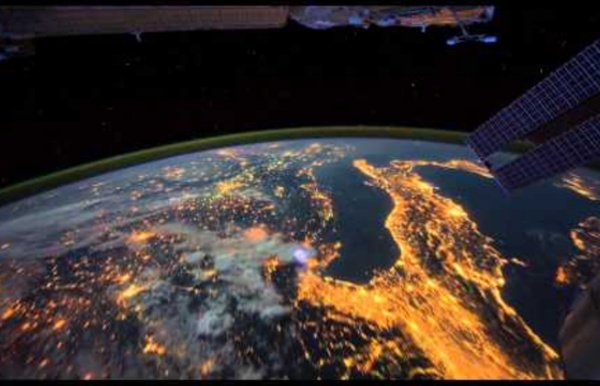



http://www.youtube.com/watch?v=FG0fTKAqZ5g
Related: Earth & Space • EARTH ~ SO BEAUTIFUL 2 • SPACE ~ 8 • EARTHMars’ Atmosphere Stripped by Solar Winds, NASA Says This video is not currently supported on your browser. Advertisement Continue reading the main story Video How Well Do You Know Your Canadian Rockies? Rising to a height of almost 4,000 metres, Mount Robson is the tallest peak in the Canadian Rockies. Its heavily glaciated flanks are frequently photographed by passengers onboard Rocky Mountaineer’s “Journey Through the Clouds” and “Rainforest to Goldrush” routes, as the trains near the end of their eastward journeys to Jasper from Vancouver. Robson’s peak, however, isn’t photographed quite as often—only because it’s so high, it’s frequently obscured by dense bank of alpine clouds. Rising to a height of almost 4,000 metres, Mount Robson is the tallest peak in the Canadian Rockies.
Northern lights set to shimmer through the sky after massive solar flare and radiation storm “The Jan. 7, 2014, X-class flare was also associated with a coronal mass ejection, or CME, another solar phenomenon that can send billions of tons of particles into space that can reach Earth one to three days later,” NASA said in a release. “These particles cannot travel through the atmosphere to harm humans on Earth, but they can affect electronic systems in satellites and on the ground.” The solar storm is already diverting airline flights around the poles and may disrupt GPS positioning devices Thursday. NASA’s solar weather service is saying the solar flare activity is overdue. Perigee "Super Moon" On May 5-6 Perigee "Super Moon" On May 5-6 May 2, 2012: The full Moon has a reputation for trouble. It raises high tides, it makes dogs howl, it wakes you up in the middle of the night with beams of moonlight stealing through drapes.
Astronomers watch black hole burp after eating a star Scientists have for the first time witnessed a black hole swallow a star and then quickly eject a flare of stellar debris moving at nearly light speed. Astrophysicists tracked the star—about the size of our sun—as it shifted from its customary path, slipped into the gravitational pull of a supermassive black hole, and was sucked in, says Sjoert van Velzen, a Hubble fellow at Johns Hopkins University. “These events are extremely rare,” says van Velzen, lead author of the study published in the journal Science. “It’s the first time we see everything from the stellar destruction followed by the launch of a conical outflow, also called a jet, and we watched it unfold over several months.” Black holes are areas of space so dense that irresistible gravitational force stops the escape of matter, gas, and even light, rendering them invisible and creating the effect of a void in the fabric of space. [Giant black hole in normal galaxy breaks the rules]
Virtual Day Trips You Can Now Take Online There is arguably no name more famous or influential in American architecture than Frank Lloyd Wright and perhaps no greater example of his work then the home, school, studio, and garden sanctuary he called Taliesin. Located in Spring Green, Wisconsin, his 800-acre state wasn’t just the architecture’s home, it served as his creative laboratory and the grounds hold examples of buildings from nearly every decade of his career. If you’d like to explore Taliesin but can’t make it to Wisconsin in person, be sure to take the 3D Virtual Reality Tour. Step inside his home, studio, school, and explore the estate grounds. We may see the Northern lights across southern Canada on Thursday as the sun enters its 25th solar cycle Article content continued More On This Topic “We are prepared,” he says.
This Is What Supercontinent Pangea Looks Like Mapped With Modern Borders Imagine traveling from China to Antarctica, crossing through Canada, Brazil and India – without setting foot in any water. Unfortunately, you’ve missed your chance long ago as the supercontinent of Pangea no longer exists. But thanks to the illustrative talents of Massimo Pietrobon, you can see how Pangea may have looked before the epic landmass started ripping itself apart 200 million years ago to form the continents and countries of the world today. Image Credit: Massimo Pietrobon
San Francisco Bay The Copernicus Sentinel-2 mission takes us over San Francisco Bay in the US state of California. Zoom in to view this image at its full 10 m resolution. San Francisco Bay, almost 100 km in length, is a shallow estuary surrounded by the San Francisco Bay Area – an extensive metropolitan region that is dominated by large cities such as San Francisco, Oakland and San Jose. The densely populated urban areas around the bay contrast strongly with the surrounding green forest and park areas. In the upper right of the image, the delta of the Sacramento and San Joaquin rivers is visible – with the brown, sediment-filled water flowing down into San Pablo Bay.
Asteroid samples leave Japan scientists 'speechless' Scientists in Japan said Tuesday they were left "speechless" when they saw how much asteroid dust was inside a capsule delivered by the Hayabusa-2 space probe in an unprecedented mission. © Handout Scientists in Japan said they were speechless at how much asteroid dust was delivered by… The Japanese probe collected surface dust and pristine material last year from the asteroid Ryugu, around 300 million kilometres (200 million miles) away, during two daring phases of its six-year mission. This month it dropped off a capsule containing the samples, which created a fireball as it entered the Earth's atmosphere, and landed in the Australian desert before being transported to Japan.